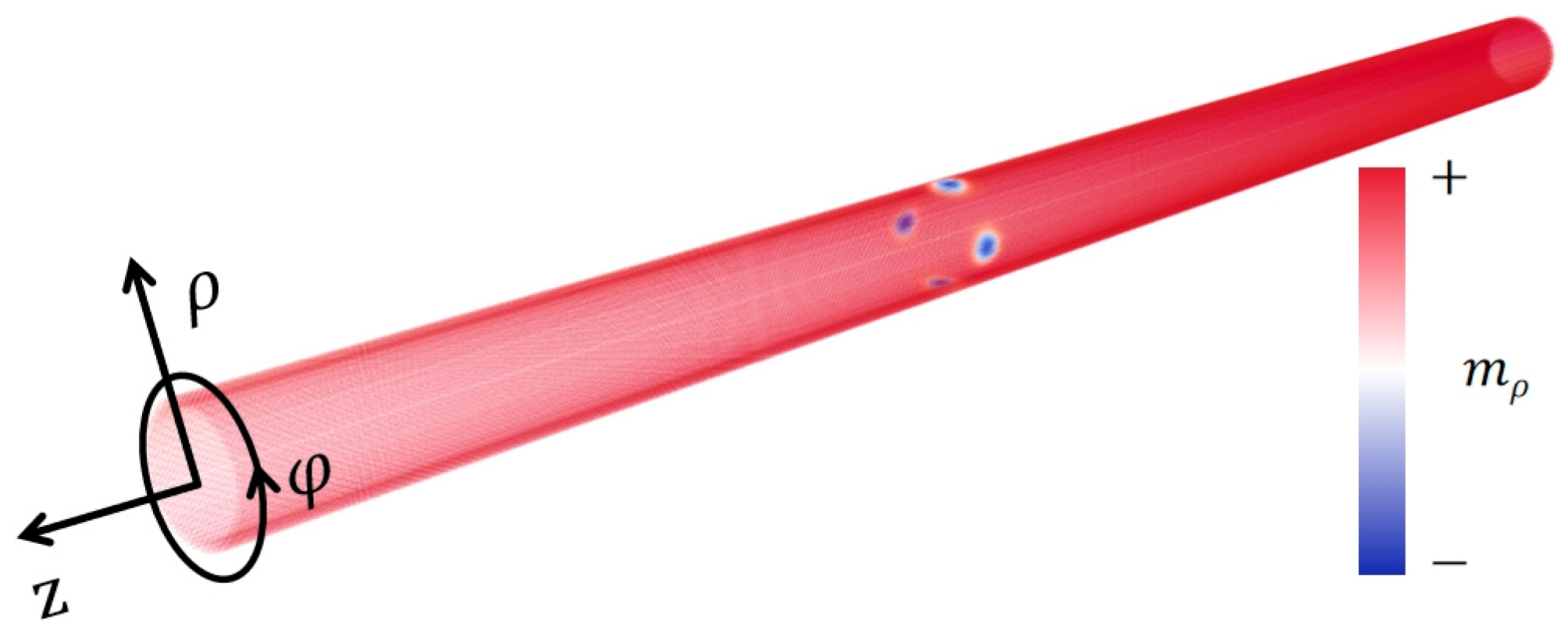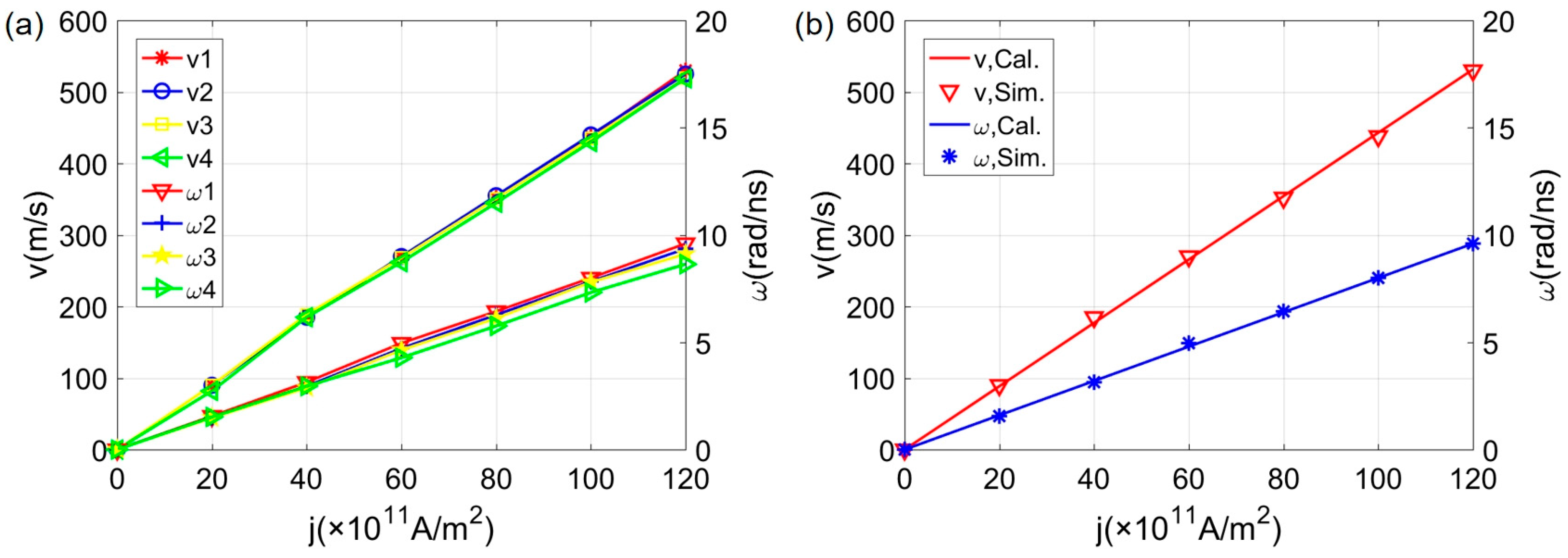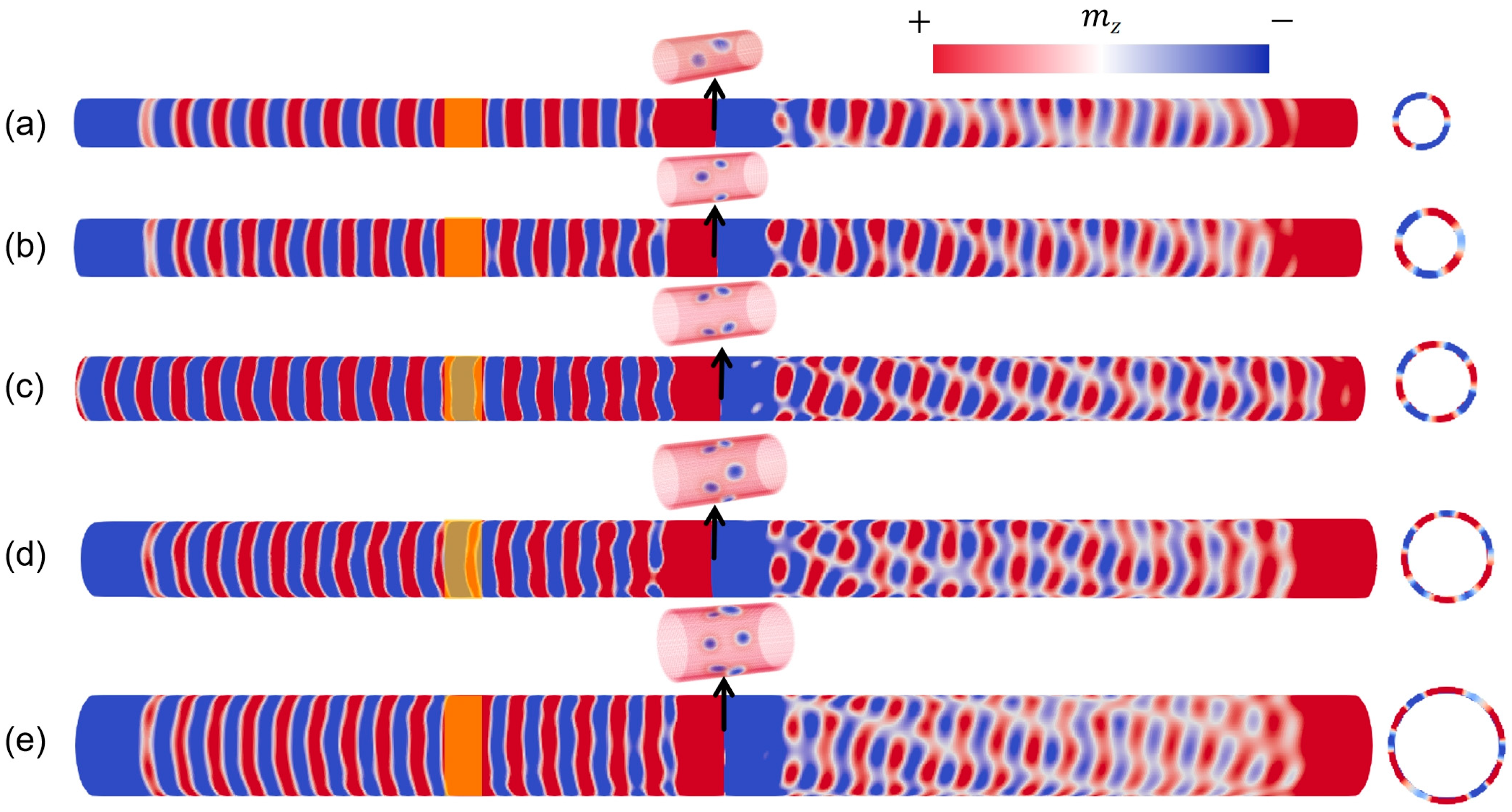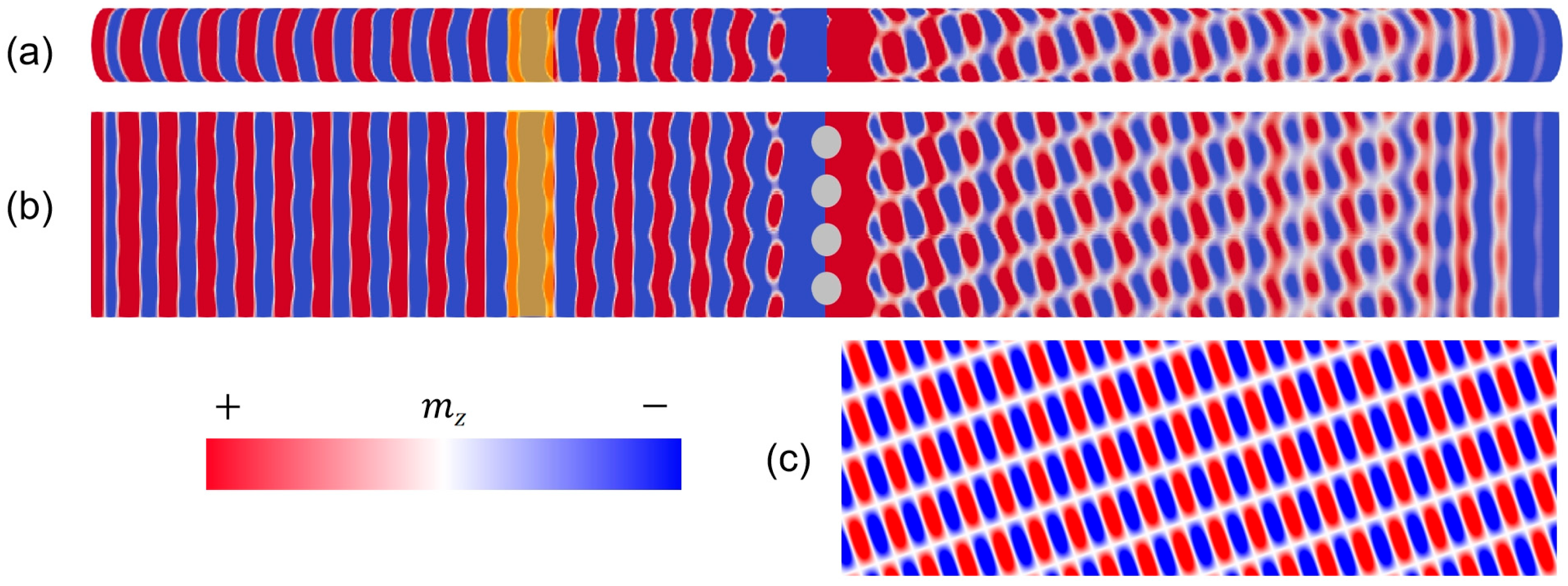Spin Wave Chiral Scattering by Skyrmion Lattice in Ferromagnetic Nanotubes
Abstract
:1. Introduction
2. Materials and Methods
3. Results
4. Discussion
5. Conclusions
Author Contributions
Funding
Data Availability Statement
Acknowledgments
Conflicts of Interest
References
- Roßler, U.K.; Bogdanov, A.N.; Pfleiderer, C. Spontaneous skyrmion ground states in magnetic metals. Nature 2006, 442, 797–801. [Google Scholar] [CrossRef]
- Muhlbauer, S.; Binz, B.; Jonietz, F.; Pfleiderer, C.; Rosch, A.; Neubauer, A.; Georgii, R.; Böni, P. Skyrmion lattice in a chiral magnet. Science 2009, 323, 915–919. [Google Scholar] [CrossRef] [PubMed]
- Munzer, W.; Neubauer, A.; Adams, T.; Mühlbauer, C.; Franz, F.; Jonietz, R.; Böni, P.; Pedersen, B.; Schmidt, M.; Rosch, A.; et al. Skyrmion lattice in the doped semiconductor Fe1−xCoxSi. Phys. Rev. B 2010, 81, 041203. [Google Scholar] [CrossRef]
- Yu, X.Z.; Onose, Y.; Kanazawa, N.; Park, J.H.; Han, J.H.; Nagaosa, N.; Tokura, Y. Real-space observation of a two-dimensional skyrmion crystal. Nature 2010, 465, 901–904. [Google Scholar] [CrossRef] [PubMed]
- Derras-Chouk, A.; Chudnovsky, E.M.; Garanin, D.A. Dynamics of the collapse of a ferromagnetic skyrmion in a centrosymmetric lattice. Phys. Rev. B 2022, 105, 134432. [Google Scholar] [CrossRef]
- Fert, A.; Cros, V.; Sampaio, J. Skyrmions on the track. Nat. Nanotechnol. 2013, 8, 152–156. [Google Scholar] [CrossRef]
- Yu, X.Z.; Kanazawa, N.; Zhang, W.Z.; Nagai, T.; Hara, T.; Kimoto, K.; Matsui, Y.; Onose, Y.; Tokura, Y. Skyrmion flow near room temperature in an ultralow current density. Nat. Commun. 2012, 3, 988. [Google Scholar] [CrossRef]
- Iwasaki, J.; Mochizuki, M.; Nagaosa, N. Current-induced skyrmion dynamics in constricted geometries. Nat. Nanotechnol. 2013, 8, 742–747. [Google Scholar] [CrossRef]
- Jonietz, F.; Mühlbauer, S.; Pfleiderer, C.; Neubauer, A.; Münzer, W.; Bauer, A.; Adams, T.; Georgii, R.; Böni, P.; Duine, R.A.; et al. Spin transfer torques in MnSi at ultralow current densities. Sciencce 2010, 330, 1648–1651. [Google Scholar] [CrossRef]
- Yang, S.H.; Ryu, K.S.; Parkin, S. Domain-wall velocities of up to 750 m s−1 driven by exchange-coupling torque in synthetic antiferromagnets. Nat. Nanotechnol. 2015, 10, 221–226. [Google Scholar] [CrossRef]
- Dzyaloshinsky, I. A thermodynamic theory of “weak” ferromagnetism of antiferromagnetics. J. Phys. Chem. Solids 1958, 4, 241–255. [Google Scholar] [CrossRef]
- Moriya, T. Anisotropic superexchange interaction and weak ferromagnetism. Phys. Rev. 1960, 120, 91. [Google Scholar] [CrossRef]
- Di, K.; Zhang, V.L.; Lim, H.S.; Ng, S.C.; Kuok, M.H.; Yu, J.; Yoon, J.; Qiu, X.; Yang, H. Direct Observation of the DzyaloshinskiiMoriya Interaction in a Pt/Co/Ni Film. Phys. Rev. Lett. 2015, 114, 047201. [Google Scholar] [CrossRef] [PubMed]
- Schütte, C.; Iwasaki, J.; Rosch, A.; Nagaosa, N. Inertia, diffusion, and dynamics of a driven skyrmion. Phys. Rev. B 2014, 90, 174434. [Google Scholar] [CrossRef]
- Neubauer, A.; Pfleiderer, C.; Binz, B.; Rosch, A.; Ritz, R.; Niklowitz, P.G.; Böni, P. Topological Hall effect in the a phase of MnSi. Phys. Rev. Lett. 2009, 102, 186602. [Google Scholar] [CrossRef]
- Yi, S.D.; Onoda, S.; Nagaosa, N.; Han, J.H. Skyrmions and anomalous Hall effect in a Dzyaloshinskii -Moriya spiral magnet. Phys. Rev. B 2009, 80, 054416. [Google Scholar] [CrossRef]
- Chen, G. Skyrmion Hall effect. Nat. Phys. 2017, 13, 112–113. [Google Scholar] [CrossRef]
- Zang, J.; Mostovoy, M.; Han, J.H.; Nagaosa, N. Dynamics of skyrmion crystals in metallic thin films. Phys. Rev. Lett. 2011, 107, 136804. [Google Scholar] [CrossRef]
- Peng, L.; Karube, K.; Taguchi, Y.; Nagaosa, N.; Tokura, Y.; Yu, X. Dynamic transition of current-driven single-skyrmion motion in a room-temperature chiral-lattice magnet. Nat. Commun. 2021, 12, 6797. [Google Scholar] [CrossRef]
- Feilhauer, J.; Saha, S.; Tobik, J.; Zelent, M.; Heyderman, L.J.; Mruczkiewicz, M. Controlled motion of skyrmions in a magnetic antidot lattice. Phys. Rev. B 2020, 102, 184425. [Google Scholar] [CrossRef]
- Yang, S.; Wu, K.; Zhao, Y.; Liang, X.; Xia, J.; Zhou, Y.; Xing, X.; Zhou, Y. Inhibition of Skyrmion Hall Effect by a Stripe Domain Wall. Phys. Rev. Appl. 2022, 18, 024030. [Google Scholar] [CrossRef]
- Wang, X.; Wang, X.S.; Wang, C.; Yang, H.; Cao, Y.; Yan, P. Current-induced skyrmion motion on magnetic nanotubes. J. Phys. D Appl. Phys. 2019, 52, 225001. [Google Scholar] [CrossRef]
- Wang, W.; Hu, P.; Kong, L.; Song, D.; Du, H. Magnetic skyrmion Walker breakdown in cylindrical nanotubes. Phys. Rev. B 2023, 107, 134407. [Google Scholar] [CrossRef]
- Bao, B.; Yang, M.; Yan, M. Asymmetric motion of magnetic skyrmions in ferromagnetic nanotubes induced by a magnetic field. Symmetry 2022, 14, 1195. [Google Scholar] [CrossRef]
- Holanda, J. Analyzing the magnetic interactions in nanostructures that are candidates for applications in spintronics. J. Phys. D Appl. Phys. 2021, 54, 245004. [Google Scholar] [CrossRef]
- Jamali, M.; Kwon, J.H.; Seo, S.M.; Lee, J.; Yang, H. Spin wave nonreciprocity for logic device applications. Sci. Rep. 2013, 3, 3160. [Google Scholar] [CrossRef]
- Chumak, A.V.; Vasyuchka, V.I.; Serga, A.A.; Hillebrands, B. Magnon spintronics. Nat. Phys. 2015, 11, 453–461. [Google Scholar] [CrossRef]
- Cornelissen, L.J.; Liu, J.; Duine, R.A.; Ben Youssef, J.; van Wees, B.J. Long-distance transport of magnon spin information in a magnetic insulator at room temperature. Nat. Phys. 2015, 11, 1022–1026. [Google Scholar] [CrossRef]
- Liu, C.P.; Chen, J.L.; Liu, T.; Heimbach, F.; Yu, H.M.; Xiao, Y.; Hu, J.F.; Liu, M.C.; Chang, H.C.; Stueckler, T.; et al. Long-distance propagation of short-wavelength spin waves. Nat. Commun. 2018, 9, 738. [Google Scholar] [CrossRef]
- Chumak, A.V.; Serga, A.A.; Hillebrands, B. Magnon transistor for all-magnon data processing. Nat. Commun. 2014, 5, 4700. [Google Scholar] [CrossRef]
- Zhang, X.; Ezawa, M.; Xiao, D.; Zhao, G.P.; Liu, Y.; Zhou, Y. All-magnetic control of skyrmions in nanowires by a spin wave. Nanotechnology 2015, 26, 225701. [Google Scholar] [CrossRef] [PubMed]
- Zhang, X.; Müller, J.; Xia, J.; Garst, M.; Liu, X.; Zhou, Y. Motion of skyrmions in nanowires driven by magnonic momentum-transfer forces. New J. Phys. 2017, 19, 065001. [Google Scholar] [CrossRef]
- Bo, L.; Hu, C.; Kong, L.; Ji, L.; Li, Y.; Zhang, J.; Zhao, R.; Zhang, X. Velocity increase of skyrmion motion by constructing wedge nanotracks. J. Magn. Magn. Mater. 2022, 546, 168877. [Google Scholar] [CrossRef]
- Schütte, C.; Garst, M. Magnon-skyrmion scattering in chiral magnets. Phys. Rev. B 2014, 90, 094423. [Google Scholar] [CrossRef]
- Iwasaki, J.; Beekman, A.J.; Nagaosa, N. Theory of magnon-skyrmion scattering in chiral magnets. Phys. Rev. B 2014, 89, 064412. [Google Scholar] [CrossRef]
- Ma, X.; Ai, X.; Yang, X.; Cai, M.; Shim, J.; Piao, H. Gyromotion of skyrmion along the nanofilm edge driven by spin waves. J. Magn. Magn. Mater. 2023, 581, 170665. [Google Scholar] [CrossRef]
- Otálora, J.A.; Yan, M.; Schultheiss, H.; Hertel, R.; Kákay, A. Curvature-Induced Asymmetric Spin-Wave Dispersion. Phys. Rev. Lett. 2016, 117, 227203. [Google Scholar] [CrossRef]
- Otálora, J.A.; Yan, M.; Schultheiss, H.; Hertel, R.; Kákay, A. Asymmetric spin-wave dispersion in ferromagnetic nanotubes induced by surface curvature. Phys. Rev. B 2017, 95, 184415. [Google Scholar] [CrossRef]
- Yang, M.; Yin, B.; Li, Z.; Zeng, X.; Yan, M. magnonic activity of ferromagnetic nanocylinders. Phys. Rev. B 2021, 103, 094404. [Google Scholar] [CrossRef]
- Yang, M.; Zeng, X.; Yan, M. Magnonic activity of circularly magnetized ferromagnetic nanotubes induced by dzyalonshinskii-moriya interaction. Symmetry 2022, 14, 1771. [Google Scholar] [CrossRef]
- Slonczewski, J.C. Current-driven excitation of magnetic multilayers. J. Magn. Magn. Mater. 1996, 159, L1–L7. [Google Scholar] [CrossRef]
- Zare, M. Resonance spin-transfer torque in ferromagnetic/normal-metal/ferromagnetic spin-valve structure of topological insulators. J. Magn. Magn. Mater. 2019, 492, 165605. [Google Scholar] [CrossRef]
- Gilbert, T.L. A Lagrangian formulation of the gyromagnetic equation of the magnetization field. Phys. Rev. 1955, 100, 1243. [Google Scholar]
- Zhang, S.; Li, Z. Roles of Nonequilibrium Conduction Electrons on the Magnetization Dynamics of Ferromagnets. Phys. Rev. Lett. 2004, 93, 127204. [Google Scholar] [CrossRef] [PubMed]
- Vansteenkiste, A.; Leliaert, J.; Dvornik, M.; Helsen, M.; Garcia-Sanchez, F.; Van Waeyenberge, B. The design and verification of MuMax3. AIP Adv. 2014, 4, 107133. [Google Scholar] [CrossRef]
- Sampaio, J.; Cros, V.; Rohart, S.; Thiaville, A.; Fert, A. Nucleation, stability and current-induced motion of isolated magnetic skyrmions in nanostructures. Nat. Nanotechnol. 2013, 8, 839–844. [Google Scholar] [CrossRef]
- Xie, K.; Sang, H. Three layers of skyrmions in the magnetic triple-layer structure without the Dzyaloshinsky-Moriya interaction. J. Appl. Phys. 2014, 116, 223901. [Google Scholar] [CrossRef]
- Holanda, J.; Campos, C.L.A.V.; Franca, C.A.; Padrón-Hernández, E. Effective surface anisotropy in polycrystalline ferromagnetic nanowires. J. Alloys Compd. 2014, 617, 639–641. [Google Scholar] [CrossRef]
- Abeed, M.A.; Sahoo, S.; Winters, D.; Barman, A.; Bandyopadhyay, S. The effect of material defects on resonant spin wave modes in a nanomagnet. Sci. Rep. 2019, 9, 16635. [Google Scholar] [CrossRef]
- Yan, P.; Kamra, A.; Cao, Y.; Bauer, G. Angular and linear momentum of excited ferromagnets. Phys. Rev. B 2013, 88, 144413. [Google Scholar] [CrossRef]
- Jiang, Y.; Yuan, H.; Li, Z.; Wang, Z.; Zhang, H.; Cao, Y.; Yan, P. Twisted Magnon as a Magnetic Tweezer. Phys. Rev. Lett. 2020, 124, 217204. [Google Scholar] [CrossRef] [PubMed]







Disclaimer/Publisher’s Note: The statements, opinions and data contained in all publications are solely those of the individual author(s) and contributor(s) and not of MDPI and/or the editor(s). MDPI and/or the editor(s) disclaim responsibility for any injury to people or property resulting from any ideas, methods, instructions or products referred to in the content. |
© 2024 by the authors. Licensee MDPI, Basel, Switzerland. This article is an open access article distributed under the terms and conditions of the Creative Commons Attribution (CC BY) license (https://creativecommons.org/licenses/by/4.0/).
Share and Cite
Li, N.; Fan, M.; Zeng, X.; Yan, M. Spin Wave Chiral Scattering by Skyrmion Lattice in Ferromagnetic Nanotubes. Symmetry 2024, 16, 1336. https://doi.org/10.3390/sym16101336
Li N, Fan M, Zeng X, Yan M. Spin Wave Chiral Scattering by Skyrmion Lattice in Ferromagnetic Nanotubes. Symmetry. 2024; 16(10):1336. https://doi.org/10.3390/sym16101336
Chicago/Turabian StyleLi, Na, Mingming Fan, Xiaoyan Zeng, and Ming Yan. 2024. "Spin Wave Chiral Scattering by Skyrmion Lattice in Ferromagnetic Nanotubes" Symmetry 16, no. 10: 1336. https://doi.org/10.3390/sym16101336





